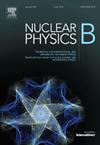Einstein–Gauss–Bonnet–Myrzakulov gravity from R + F(T,G): Numerical insights and torsion–Gauss–Bonnet dynamics in Weitzenböck spacetime
IF 2.5
3区 物理与天体物理
Q2 PHYSICS, PARTICLES & FIELDS
引用次数: 0
Abstract
The study of modified gravity models has garnered significant attention because of their potential to provide alternative explanations for cosmological phenomena, such as the accelerated expansion of the universe and the nature of dark energy. One such model, the Einstein–Gauss–Bonnet–Myrzakulov gravity (EGBMG), which incorporates the curvature R, torsion T, and the Gauss-Bonnet term G, offers a promising framework to explore the dynamics of the universe and its evolution. This paper delves into the theoretical and observational implications of the EGBMG model, focusing on its ability to address long-standing challenges in cosmology, including the evolution of dark energy and the transition from early-time inflationary behavior to late-time acceleration. We review recent advancements in the model, including its compatibility with observational data and its ability to provide new insights into cosmic acceleration. Through a combination of theoretical models, dynamical systems analysis, and cosmological diagnostics, we demonstrate the robustness of the EGBMG framework in explaining the large-scale structure of the universe and its accelerated expansion. This paper serves as a step toward further exploring the potential of this model to understand the fundamental forces driving the cosmos and its consistency with modern observational constraints in Weitzenböck spacetime.
R + 的Einstein-Gauss-Bonnet-Myrzakulov引力F(T,G): Weitzenböck时空中扭转- gauss - bonnet动力学的数值见解
修正引力模型的研究已经引起了极大的关注,因为它们有可能为宇宙现象提供另一种解释,比如宇宙的加速膨胀和暗能量的本质。一个这样的模型,爱因斯坦-高斯-邦纳-米尔扎库洛夫R+F(T,G)引力(EGBMG),它结合了曲率R,扭转T和高斯-邦纳项G,为探索宇宙动力学及其演化提供了一个有希望的框架。本文深入研究了EGBMG模型的理论和观测意义,重点关注其解决宇宙学中长期存在的挑战的能力,包括暗能量的演化和从早期暴胀行为到后期加速的转变。我们回顾了该模型的最新进展,包括它与观测数据的兼容性以及它为宇宙加速提供新见解的能力。通过理论模型、动力系统分析和宇宙学诊断的结合,我们证明了EGBMG框架在解释宇宙的大尺度结构及其加速膨胀方面的鲁棒性。本文是进一步探索该模型的潜力的一步,以了解驱动宇宙的基本力量及其与Weitzenböck时空中现代观测约束的一致性。
本文章由计算机程序翻译,如有差异,请以英文原文为准。
求助全文
约1分钟内获得全文
求助全文
来源期刊

Nuclear Physics B
物理-物理:粒子与场物理
CiteScore
5.50
自引率
7.10%
发文量
302
审稿时长
1 months
期刊介绍:
Nuclear Physics B focuses on the domain of high energy physics, quantum field theory, statistical systems, and mathematical physics, and includes four main sections: high energy physics - phenomenology, high energy physics - theory, high energy physics - experiment, and quantum field theory, statistical systems, and mathematical physics. The emphasis is on original research papers (Frontiers Articles or Full Length Articles), but Review Articles are also welcome.
 求助内容:
求助内容: 应助结果提醒方式:
应助结果提醒方式:


